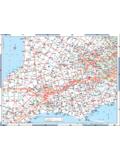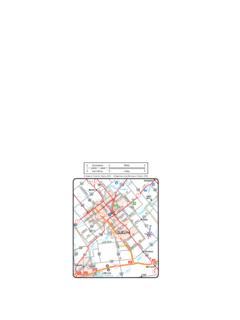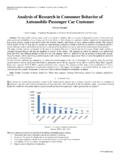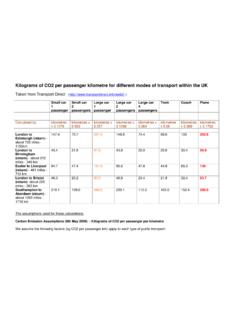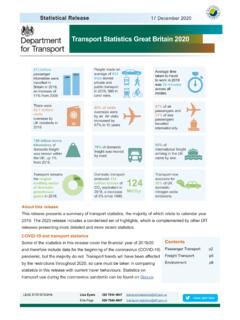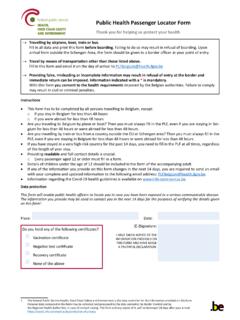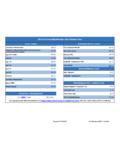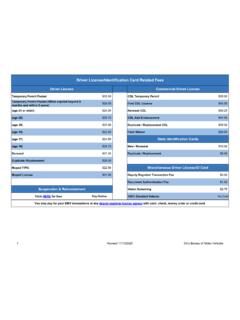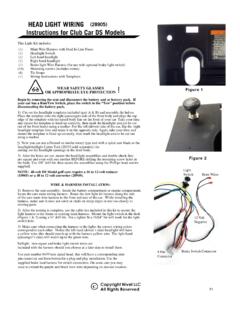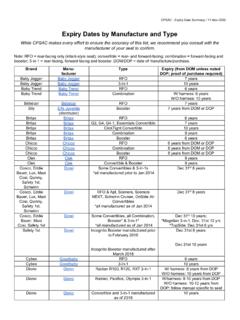Transcription of Passenger / Light-Duty Vehicle Inspection Standard
1 Passenger / Light-Duty Vehicle Inspection Standard Reference Handbook October 2015. The information contained in this document is confidential and proprietary to the Government of Ontario. Unauthorized distribution or use of this document or the information contained herein is strictly prohibited. Copyright and Disclaimer Government of Ontario reserves the right to make changes in the information contained in this publication without prior notice. The reader should in all cases consult the Ministry of Transportation to determine whether any such changes have been made. Queen's Printer for Ontario, 2015. Other product or brand names are trademarks or registered trademarks of their respective holders. This document contains proprietary and confidential information about Government of Ontario. Disclosure or reproduction is prohibited without prior express written permission. Introduction As partners in road safety, licensed Motor Vehicle Inspection Station owners and technicians must carefully review and apply the requirements contained in this technical Passenger / Light Duty Vehicle Inspection Standard (herein after referred to as the Standard ).
2 This Standard is intended to apply to Light-Duty trucks and Passenger vehicles requiring the issuance of a Safety Standards Certificate (SSC). for the purposes of Vehicle registration and/or transfer of ownership. The purpose of the Inspection is to ensure that the Vehicle meets a minimum safety Standard at the time of Inspection . A determination must be made as to whether the condition of the Vehicle at the time of the Inspection conforms to the requirements outlined in this Reference Handbook. This Standard replaces Schedules 1 and 2 of Ontario Regulation 611. Those Schedules previously contained the standards applicable to SSC inspections. All items listed in this Standard must be inspected in accordance with the specific procedures outlined. An SSC is a legal declaration that the Vehicle was inspected in accordance with the legislation, Regulation 611, and this Standard and met all of the requirements at the time of the Inspection .
3 Should you have any questions related to the requirements contained in this Standard , please refer to the Ministry of Transportation website: Table of Contents UPDATED Passenger / Light-Duty Vehicle Inspection 1. Reference Handbook ..1. 1. INSTRUCTIONS FOR TECHNICIAN / INSPECTOR CONDUCTING. INSPECTIONS ..5. Inspection Inspection Outcome Based on Current Vehicle 5. Inspection Report ..5. Workplace Informational Notes ..6. 2. TERMINOLOGY ..6. Application ..6. Definitions ..6. Categorization of Fluid (Liquid) 8. Illustrations and Diagrams Used in the 9. Measurements and Identification of Defective Conditions of the Types of Hose, Tubing and Lines Used on Vehicles ..11. SECTION 1 12. SECTION 2 23. SECTION 3 BRAKE 28. SECTION 4 STEERING .. 43. SECTION 5 INSTRUMENTS AND AUXILIARY 49. SECTION 6 52. SECTION 7 ELECTRICAL 65. SECTION 8 67. SECTION 9 TIRE AND WHEEL .. 82. SECTION 10 COUPLING 88. SECTION 11 ROAD 92. 1. Instructions for Technician / Inspector Conducting Inspections Inspection Methods The Inspection of Vehicle components and systems conducted to determine compliance with this Standard consists mainly of visual Inspection activities in Sections 1-10 and through the completion of an on-road evaluation, details of which are found in Section 11.
4 An Inspection will also involve testing, removal and/or disassembly of components, measurements and other actions in certain cases. Whenever an item requires more than a visual Inspection , additional procedures are specifically provided. These are displayed with the heading Additional Inspection Procedure(s): appearing before the text describing the necessary steps. Inspection Outcome Based on Current Vehicle Condition A pass or fail outcome of a Vehicle Inspection is based on the condition of the Vehicle at the time of the Inspection . The determination does not involve a prediction about a Vehicle 's condition in the future. Inspection Report For each SSC Inspection , the inspecting technician must complete an Inspection report. This report must be provided to the customer and retained in accordance with Ontario Regulation 601. The following items are noted in the Standard as recordable items and must be included on the Inspection report.
5 Tell-Tales indicating a fault Fuel Tank Level Tire Tread Depth Tire Inflation Pressure (Initial and final) if corrected by more than 5psi Disc Brakes - Rotor Thickness - Pad (Friction) Material Thickness of Inner and Outer Brake Pad Brake Drum System - Brake Shoe Lining Thickness - Brake Drum Diameter Passenger / Light-Duty Vehicle Inspection Standard Page 5 of 96. Note: All Inspection procedures are visual unless additional Inspection procedures are indicated. Conditions shown in this manner are defined conditions. The definitions can be found in the introduction section. Additional details on the type of information that must be recorded can be found in the respective sections contained in the Standard and in the Regulation. Workplace Safety Some of the Inspection procedures described in this Standard require the use of tools and equipment, and may involve safety hazards. It is assumed that the individual performing inspections according to this Standard is fully familiar with all relevant workplace safety requirements and protocols.
6 No specific safety warnings are provided within this document. All relevant and appropriate safety precautions are the responsibility of the inspector / mechanic /. technician and the workplace where the Inspection is conducted. Informational Notes In many cases, additional information is provided to clarify the Inspection procedure or assist in consistent interpretation of the Standard . These are displayed with the heading Note: appearing before the text. 2. Terminology Application Various terms and acronyms are used throughout this Standard . These terms have specific and consistent meanings as they relate to conducting safety inspections and identifying defective conditions. The purpose of defining these terms is to support consistent interpretation and application of the language used here. The terms that are defined below are highlighted whenever they appear in each section to remind the reader that the condition is one of those that is specifically defined.
7 This reminder also appears in the footer of each page of this document. Definitions The meaning of each of the terms, for the purposes of conducting inspections according to this Standard , is as follows: abnormally worn means unusual, excessive or exceptional wear of a Vehicle component indicative of the presence of some deterioration or defect in that component, or in a related part of a Vehicle . It is acknowledged that for many Passenger / Light-Duty Vehicle Inspection Standard Page 6 of 96. Note: All Inspection procedures are visual unless additional Inspection procedures are indicated. Conditions shown in this manner are defined conditions. The definitions can be found in the introduction section. components and systems some level of wear is normal and does not have any effect on Vehicle safety. It is expected that the technician knows the amount and type of wear that is (normal based on the age and operation of a Vehicle .)
8 ANSI means standards developed by the American National Standards Institute (ANSI). broken means burst, cracked, crushed or damaged. CCMTA means Canadian Council of Motor Transport Administrators (CCMTA). CMVSS means Canada Motor Vehicle Safety Standards (CMVSS) and their supporting Technical Standards Documents. These are Canadian safety standards for vehicles that were developed and are updated by Transport Canada. crazed a network of fine cracks in the surface damaged means any unintended condition, or condition caused by means other than normal use, that is likely to impair normal function. FMVSS means Federal Motor Vehicle Safety Standards. These are United States safety standards for vehicles that were developed and are updated by the National Highway Traffic Safety Administration of the Department of Transport. industry Standard means installation, modification or repair methods described in industry-accepted standards or recommended practices published by Mitchell Repair Information Company, ALLDATA, the Society of Automotive Engineers (SAE), I-CAR, Canadian Standards Association (CSA) and other similar documents from similar organizations.
9 Inoperative means a Vehicle component or system that does not operate the way it normally operates or the Vehicle manufacturer intended it to operate. insecure means (a) a component is becoming detached due to deterioration of the means of attachment, or (b) the means of attachment is unable to withstand normal Vehicle operation or is not at least equivalent to the OEM. Standard means of attachment. loose means that an item is detached, or no longer fully attached, due to improper installation, failure or deterioration of one or more means of attachment. missing means that an item is absent (such as removed or detached ) that is ordinarily present on the Vehicle , was present on the Vehicle when the Vehicle was manufactured, or is required for normal and safe Vehicle operation. Passenger / Light-Duty Vehicle Inspection Standard Page 7 of 96. Note: All Inspection procedures are visual unless additional Inspection procedures are indicated.
10 Conditions shown in this manner are defined conditions. The definitions can be found in the introduction section. manufacturer means the manufacturer of the Vehicle , the manufacturer of a major Vehicle component or system, or manufacturer of aftermarket parts that are direct replacements for OEM parts. OEM means original equipment manufacturer and refers to the brand name manufacturer of the Vehicle . OEM Standard means the manufacturing methods, component and assembly quality levels, and performance levels set by the manufacturer of a Vehicle or Vehicle component to ensure a Vehicle is able to perform safely as intended. It includes component quality, performance levels, repair methods, durability, safety and the service methods outlined in the warranty and service literature provided for the use and maintenance of a Vehicle . Parts supplied by OEM, and established aftermarket manufacturers of parts intended for direct replacement of OEM parts, are generally considered to meet OEM Standard operate as intended means the manner in which a Vehicle component or system ordinarily operates, operated when the Vehicle was manufactured, or is required to operate for normal and safe Vehicle operation reject if means a condition if present at the time of Inspection or after repairs that results in a failed Inspection .

